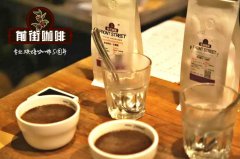What is the principle of hand-brewing coffee? how to adjust the water temperature of hand-brewing coffee in winter

Professional coffee knowledge exchange more coffee bean information please follow the coffee workshop (Wechat official account cafe_style)
The principle of making coffee by hand
The so-called brewing coffee is actually the process of extracting the molecules from the coffee cells, and this process includes the following three steps: wetting, dissolution, and release, which occur one after another and interact with each other, and finally produce the special flavor of coffee. We will explain the following one by one:
Step 1: get wet
Literally, coffee powder gets wet when it touches water, which is the starting point when coffee cells begin to release molecules.
It should be noted that roasted coffee beans are filled with carbon dioxide, and the fresher the beans, the more carbon dioxide they contain. When the hot water touches the coffee powder, the carbon dioxide will run out first, forming a layer of air bubbles on the surface, and you will see the coffee powder in the filter cup begin to expand (pictured below). At this time, the coffee cell is like a supermarket that a lot of people have to squeeze out of the inside, and people outside can't get in at all-in the same way, hot water outside the cell can't get into the cell. Therefore, after wetting the coffee powder, we will stop injecting water and wait for the complete release of carbon dioxide and the coffee powder to stop expanding and then continue to heat the water in order to achieve a better extraction effect.
Step 2: dissolve
Refers to the process of dissolving soluble molecules in coffee cells in hot water, which is the most important step in deciding to extract the flavor of coffee.
Coffee beans 2/3 are made up of insoluble cellulose and 1/3 are soluble odor molecules that are dissolved in order according to the size of the molecules when they come into contact with water. The first small molecules dissolved include acidity and aroma, then the sweetness of middle molecules, and finally the bitter taste of macromolecules, which is where the different levels of coffee taste come from. Therefore, if you like the sweeter taste, the extraction time should be shorter, because the longer the hot water stays on the coffee powder, the more bitter molecules will be dissolved.
Step 3: diffusion
After the odor molecules dissolve, they leave the coffee cells by osmosis, a process called diffusion. After the odor molecules are diffused into hot water, the final coffee extract is formed.

Factors affecting hand-brewed coffee
Once you understand the principle, you should be able to understand the effect of different hand-brewing conditions on the flavor of coffee. All the different factors actually revolve around one core: extraction time, that is, the time when coffee powder reacts with hot water. We have sorted out some important factors below:
Uniformity of coffee powder particles: the extraction speed of fine coffee powder is fast, while that of coarse coffee powder is slow, and the complete extraction time is different. If the powder particles are not uniform, it is possible that the fine coffee powder has begun to release bitter molecules, and the coarse coffee powder has not been extracted completely, resulting in a poor flavor of the final coffee. If the coffee powder is evenly granulated, there will be no such problem.
Coffee powder particle size: the finer the coffee powder, the longer the hot water will flow through the coffee powder.
Filter paper thickness: the thicker the filter paper, the slower the flow rate of the extract, and the longer the interaction between hot water and coffee powder.
Water injection speed and method: water injection is uniform and stable, so that the extraction speed of coffee powder is the same. In addition, the height of water injection will also affect the water temperature, so it is recommended to get as close to the filter cup as possible and inject water by repeated loops.
Water temperature: the higher the water temperature, the faster the extraction speed. It is generally recommended that the deep-roasted coffee beans should be boiled at 90 degrees 80muri, while the lightly roasted coffee beans should be boiled at 90Mui 97 degrees.
Most of these factors are not standard, because everyone likes the taste of coffee is different, how to adjust different factors, rush out their favorite taste, is the most interesting part of hand-brewed coffee. For example, if you want to drink bitter coffee, you can use finer coffee powder, higher water temperature, or longer water injection time to achieve the desired taste.

How to adjust the water temperature of hand coffee in winter?
When the temperature is high in summer, the change of the water temperature in the hand pot is not obvious in 2-3 minutes, but when the temperature is lower in winter, the hot water may cool quickly, resulting in the lower temperature in the final cooking and the lack of body in the latter half, so the taste will be a little thin and the aftertaste will not be long. Therefore, the editor suggests that when you pour hot water into the pot, you can pour more hot water into the pot than usual. A sufficient amount of hot water can keep the hot water in your hand pot against the cold room temperature and maintain the water temperature, which is always important for brewing coffee. If there are great changes in the environment for brewing coffee, such as temperature, humidity, wind. When you wait, don't forget to be flexible and modify your cooking data a little bit, so you won't be afraid to rush to the second half of the extraction and lose its taste.
Important Notice :
前街咖啡 FrontStreet Coffee has moved to new addredd:
FrontStreet Coffee Address: 315,Donghua East Road,GuangZhou
Tel:020 38364473
- Prev

The effect of milk on espresso? How to choose milk?
Professional coffee knowledge exchange more coffee bean information please follow the coffee workshop (Wechat official account cafe_style) what kind of espresso is good [part 1] Let's first understand the soul components of espresso! Italian concentrated espresso, milk and milk foam. [Italian concentrate] what does a good Espresso look like if you look at the surface
- Next

Jamaican coffee brewing method Jamaican Blue Mountain Coffee pressing pot for brewing and grinding powder thickness
Professional coffee knowledge exchange more coffee bean information Please follow the coffee workshop (Wechat official account cafe_style). All along, Blue Mountain Coffee in Jamaican coffee has won the favor of many coffee lovers because of its unique taste of sour, fragrant, mellow, sweet and bitter, as well as strong aroma. So, how to make the Blue Mountain Coffee of Jamaican Coffee better?
Related
- Beginners will see the "Coffee pull flower" guide!
- What is the difference between ice blog purified milk and ordinary milk coffee?
- Why is the Philippines the largest producer of crops in Liberia?
- For coffee extraction, should the fine powder be retained?
- How does extracted espresso fill pressed powder? How much strength does it take to press the powder?
- How to make jasmine cold extract coffee? Is the jasmine + latte good?
- Will this little toy really make the coffee taste better? How does Lily Drip affect coffee extraction?
- Will the action of slapping the filter cup also affect coffee extraction?
- What's the difference between powder-to-water ratio and powder-to-liquid ratio?
- What is the Ethiopian local species? What does it have to do with Heirloom native species?

